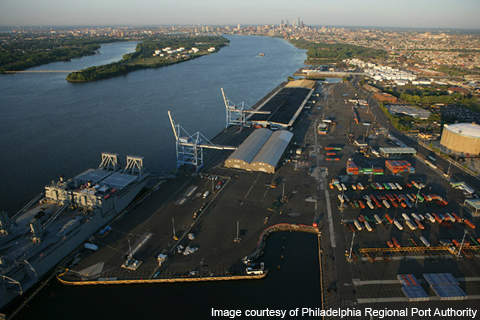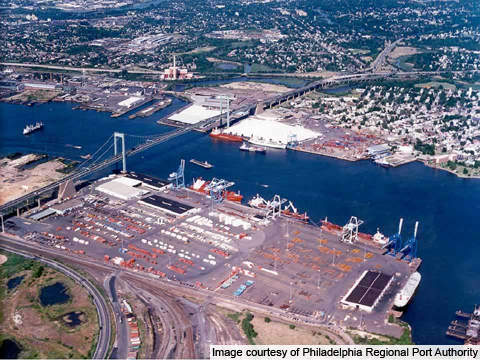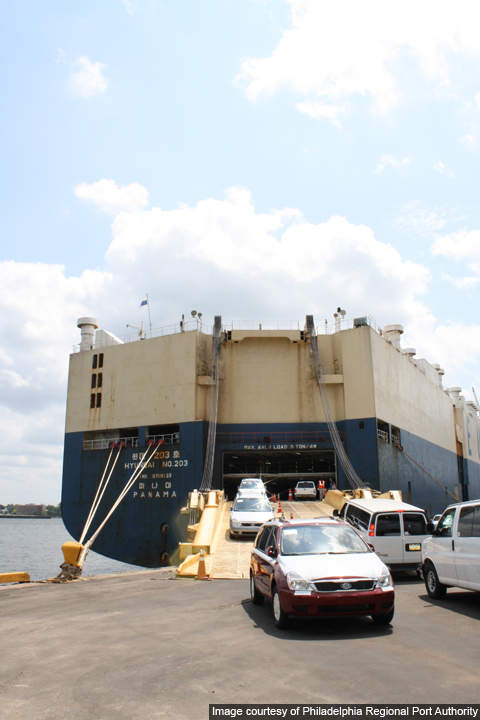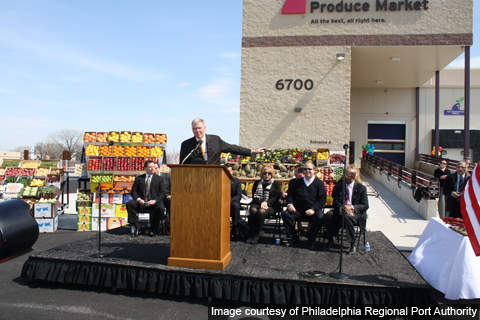The Port of Philadelphia is situated on the bank of the Delaware River, 151km south of New York City and 216km north of Washington D.C. The port is believed to be the number one perishables port in the USA.
The port facilities are located along a five kilometre stretch of the river within the limits of Philadelphia, Pennsylvania.
The port was designated as a strategic military seaport by the Defence Department in 2002. It registered a 17% increase on its total cargo output in 2010, handling 3.64 million metric tons (mt) of cargo against 3.11mt in 2009.
Containerised cargo grew from 222,900 TEUs in 2009 to 264,059 TEUs in 2010, an increase of 18% year on year. Non-containerised cargoes posted growth of 32%.
The Philadelphia Regional Port Authority (PRPA) takes care of the management, maintenance, marketing and promotion of the port facilities. The PRPA, created in 1989 by an act of the Pennsylvania legislature, is an independent agency of the Commonwealth of Pennsylvania.
Philadelphia Port design features
The depth of the river channel at the port is 40ft. The Packer Avenue Marine Terminal has an area of 112 acres. Its depth at mean low water (MLW) is 12.2m. Piers 96 and 98 have a combined terminal area of approximately 55 acres and an alongside depth of 9.75m. Terminal area of Pier 84 is 13.9 acres. It is served by a 260.6m long berth.
Terminal area of Pier 82 is 13.3 acres, that of Piers 78 and 80 is 44.4 acres, and that of Piers 38 and 40 is 12 acres. Tioga Marine Terminal has a terminal area of 116 acres and alongside depth of 10.8m.
Philadelphia Port construction
The Port of Philadelphia is more than 300 years old. Most of the port’s facilities, including piers and waterfront warehouses, were built and maintained by private concerns in its early years of operation. These facilities were built without major help from the central government or its agencies.
Major improvements took place at the port in 1960s and 70s. The Packer Avenue Marine Terminal and Tioga Marine Terminal were built during this period.
The PRPA, after its creation in 1989, built an additional on-dock warehouse at Tioga Marine Terminal, a forest products warehouse at the Piers 78/80 Forest Products Distribution Centre and a refrigerated warehouse at Pier 82.
Delaware River Main Channel Deepening Project was commenced in March 2010 to deepen the main navigation channel to 45ft. The $311m project is being undertaken by the US Army Corps of Engineers. The federal government will fund about two-thirds of the cost and the remainder will be borne by PRPA.
Port facilities and critical functions
The Port of Philadelphia is served by two terminals and eight piers. The Packer Avenue Marine Terminal is the largest and the busiest facility, and is specialised in handling heavy lift, steel products, containers, frozen meat and fruits. It is served by six berths and a roll-on / roll-off (RO/RO) ramp. It has two dry and one refrigerated storage warehouses.
The Tioga Marine Terminal is considered as a base for the Chilean fruit business. It also handles paper, containers, plywood, breakbulk cargo and steel. It has one compartmented warehouse, two dry warehouses and a cold storage with racked storage for 6,000 pallets.
Piers 96 and 98 are served by two berths and specialised in handling automobiles, project, trucks and heavy equipment cargoes. They are facilitated with an auto-washing shed and a service building.
Cocoa beans and cocoa products are handled at Pier 84 which is served by one container berth. The pier has two dry storage warehouses. Pier 82 is a 13.3 acre facility specialised in handling breakbulk, paper, fruits and vegetables.
Piers 78 and 80 handle newsprint, coated paper, wood pulp other forest products. Pier 80 has two container berths with RO/RO ramps. Piers 38 and 40 are served by three container berths.
Operators involved in the Port of Philadelphia
Packer Avenue Marine Terminal is operated by Greenwich Terminals, while Tioga Marine Terminal is operated by Delaware River Stevedores. Piers 38, 40, 78 and 80 are operated by Penn Warehousing and Distribution. Pier 82 is operated by Horizon Stevedoring, while Dependable Distribution Services is the operator of Pier 84.
Equipment used at the versatile port
Packer Avenue Marine Terminal has one Kocks heavy lift container crane, three Kocks container cranes, one Paceco container crane and two Hyundai container cranes.
Terminal equipments include 11 toploaders, 100 forklifts and eight reach stackers.
Piers 96 and 98 are equipped with forklifts, shuttle equipment and rail loading equipment.
Piers 78 and 80 are provided with more than 100 customised lift trucks, 40 tractors, 30 vans, 35 flatbeds and five fifth wheels.
Piers 38 and 40 are provided with 25 forklifts, 30 tractors, 20 vans and 35 flatbeds. Pier 82 is equipped with a Liebherr Mobile Harbor Crane.
Tioga Marine Terminal is set up with two Kocks container gantry cranes and a Liebherr Mobile Harbor Crane.
Future plans for construction and expansion
The PRPA has planned to expand the port facilities by constructing Southport Marine Terminal in order to increase the port’s capacity by three times. The terminal is estimated to cost $2bn to $3bn and is expected to be completed in 2014.
Bids for the design and construction of the facility were sought in May 2010. A consortium of Delaware River Stevedores, Marine and Ports America Group and Hyundai Merchant Marine Shipping Agency was selected as the winning bidder in October 2010.









